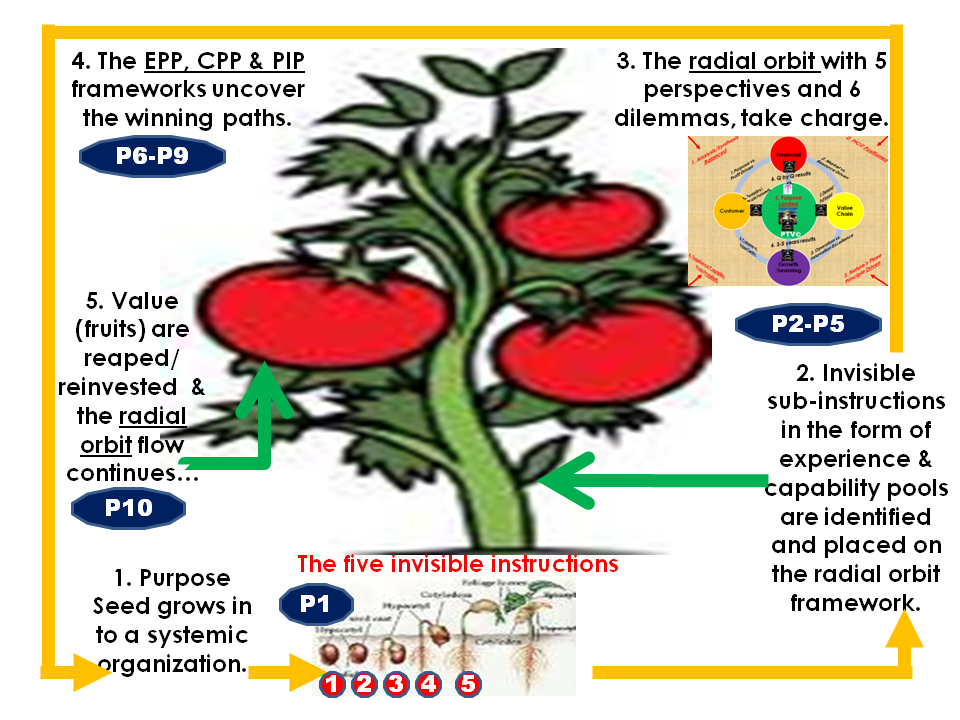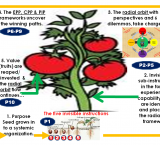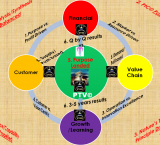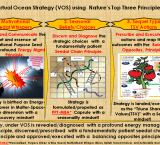Story:
Virtual Ocean Strategy (VOS), the Purpose Driven Way: Using Universe/Nature’s Top 3 Principles (Energy Management, Seasonality Driven Seedal Chain & Balancing the Opposites Principles)
To answer this cahllenge, we have developed a compelling Virtual Ocean Strategy (VOS) framework, that is formulated, at the confluence of 5 categories of principles i.e. cyclical free market economics principles, behavioral/social economics principles, quantum physics/digital principles, spirituality principles and leadership principles with a goal of creating value with a multiplier effect.
While strategy has been defined many different ways, in the last 50 years, if at all there is an agreement among experts, strategy is all about creating/multiplying/accelerating value creation. And if we start with that framing, value, per the Zen of corporate finance formula (V=Profit x (1- g/ROIC)/ (WACC-g)]) happens to be driven by two key levers (ROIC and growth) and so, for a strategy to be creating maximum value, it must find ways, to increase both levers simultaneously.
When we look at most modern day strategic planning approaches, with this value creation lens, they, by and large, are centered on the goal of increasing the resource returns (ROIC) and growth (g), by assuming value pie, as a fixed pie, and so, it ends up inherently encouraging companies, to compete with a zero sum mindset. This is where, we asked ourselves, how do we not only, increase both levers (ROIC and growth) simultaneously, but also, grow the value pie size exponentially (to infinity?), so that we can inspire/motivate companies, to both compete and collaborate simultaneously?
Simply put, the question we asked was
• How do we multiply value, not only, by leveraging resources/capabilities (ROIC), but also, by producing new market (g) segments simultaneously, that never existed before?
When we go with this framing, it not only, enlarged our mindsets, but also, helped us to trace the roots of this value creation process, all the way back to the creation of the universe, and inspired us to ask ourselves, what it takes, to look at the value creation process, with the mind of the creator of the universe? Sure enough, we distilled them in the form of 3 hypotheses/questions
1. With resources of our planet happen to be the weakest link, performance is as good as your weakest link, and so, what if there is a "platform planet" out there, where resources are not only plentiful (infinity?), but also, lends itself to train our mindsets, to creatively combine brick & mortar resources with virtual resources(as they are available in plenty), with a mindset of "traditional resource constraints are irrelevant" -> Increasing ROIC by Digital thinking
2. New markets do not come that easy – and this is where, we asked ourselves: Is it possible to make market segments seemingly look bigger, by creatively redrawing traditional industry structure boundaries, with a mindset of "traditional industry structures are irrelevant"? -> Increasing growth lever by Design/emergent thinking
3. When we follow the traditional diagnosis/prescription type of a strategy formulation process, we are limited by the value chain boundaries of a company (at the maximum industry structures) and so we asked, what if, if we reverse that process, with a prescription/diagnosis mindset - would it not, help us to imagine the end state (with sky is the limit mind set) and help us to work in reverse, to hunt for insights, with the mind of the creator of this universe(and so, to see patterns/insights, that are not visible for the traditional insights gathering mindset) and then bring that imagine end state to life (of course iteratively) ->Increase g and ROIC simultaneously with big data thinking. This hypothesis is mostly relevant for new market opportunities only and for traditional operations improvement initiatives, the best approach is, always start with diagnosis before prescription.
Sure enough, our firm’s other three key frameworks (VOS & Capitalism Plus and VizPlanet), is not only guided by these 3 hypothesis, but also, is “birthed” by the energy management principle, “propelled” by the seedal chain principle and “landed” by “balancing the opposites” principle – as outlined below in the schematic as well.
In other words, strategy under VOS is, all about serendipitously discerning the motivational seedal whisper(s) from the seasonal events, and then transforming those whispers into a seasonal choice(s), before executing them as action steps.
What do we mean?
Simply put, strategy under VOS is a seedal whisper (energy) manifesting as seasonal choices (force) within the constraint of capabilities (power) by answering following three questions, in three steps.
QUESTIONS:
- How FAR would we want to go to find our customers? – Establishing the geographical market boundaries to help answer “where to play to win” question- Scientific Force in Play
- How FAST we need to get there, to get their jobs done? – Setting the timeline expectations to help answer “when and what to play, to win” question – Scientific Power in Play
- How MUCH would it take to execute this “FAR” and “FAST” value propositions? – arriving the resource or capability choices to help answer “How do we win” question – Scientific Energy in Play
VOS answers them using with its three frameworks EPP©, CPP© , PIP©) , that is designed to inherently help organizations to derive their strategic plans from their purpose seed, using universe/natures's t.op 3 principles.
In other words, our firm’s integrated approach can be summed up with universes/nature’s top 3 principles in quantum physics/spirituality parley as follows -
Principle 1:PURPOSE SEED(Vision, Mission, BHAG, Values &Codes) morphs into management's top 3 disciplines: Leadership, Strategy & Innovation by energy management principle
Principle 2:The 3 disciplines get propelled by a 3S seasonality trajectory(seed-season-sequel) before becoming TSV value (shareholder +societal +motivational)
Principle 3:The 3S trajectory, creates 18macro dilemmas(6L+6S+6I)&few micro dilemmas and get resolved as CHOICES by "principle of balancing opposites"

Our approach is being piloted as part of our role with the following firms
- ABS Global Strategy Division (http://theacademyofbusinessstrategyglobalpartners.wordpress.com/2011/01/30/chicago-il-illinois-usa/)
- Willis Consulting LLC (http://www.willisllc.com/profiles.html), a boutique strategy consulting firm specializing on strategic planning and collaboration/OD driven innovations.
While the popular Red Ocean Strategy (ROS) and Blue Ocean Strategy (BOS) approaches have helped companies to develop some great strategies - we believe that they may not be well designed to meet the ever changing business needs of the 21st century, social media driven, connected world, with an integrated/systemic mindset.
This is where we have developed a Virtual Ocean Strategy (VOS) approach, enabled by our firm's Triune Purpose framework(TPF), in the three purpose dimensions of leadership, strategy and innovation.
- Purpose Driven Leadership Framework (http://managementexchange.com/story/leadership-purpose-driven-way-stretch-and-eustress)
- Purpose Driven PTV (http://strategywithapurpose.blogspot.com/2011/03/ptv-in-nutshell-purpose-seed-unleashing.html)
- Purpose Innovation (http://www.managementexchange.com/hack/purpose-innovation)
Within this integrated triune purpose framework mindset– we have taken a position that “words that clearly depict the aspirations of an organization (or the seeds of purpose), is the one that ultimately decides value advantage of a company, by tearing down the artificial walls between the industry structures of the 21st century social media driven digitally connected world”. In other words, an organization that embeds the right type of invisible instruction(s) within the purpose statement (seed) will definitely grow into the plant (or systemic organization) - the invisible instructions tell it to grow into. In its essence, VOS is all about – this purpose seed germinating into a plant called systemic organization, producing the fruit called value, for stake holders to reap and reinvest its benefits – as outlined in the picture below!
In other words, the purpose seed, with its five invisible instructions, is the cornerstone of PTV -
- Vision (what the firm aspires to be)
- Mission (why does the firm exist/what does it stand for)
- Values (what drives us)
- Codes (what guides us)
- BHAG (BIG HAIRY AUDACIOUS GOALS)
Together, these five part invisible instruction set, tell the purpose seed to prosper into a healthy plant called the systemic organization. Seeds, like purposes, also have invisible instruction(s) inside them – as the tomato seed turns into a tomato plant - producing the tomato fruit (as outlined in the picture on the top of the page)– very much like, how the apple seed turns into an apple tree, producing the apple fruit - and so on and so forth!
-
While the popular strategic planning approaches (ROS and BOS) have their strengths in their area of focus, none of these popular approaches, in our opinion, meet all the purpose needs, at all the time, for all the markets/industries as they are by and large industry structure bound approaches, primarily built around balancing value and cost dimensions (tradeoffs in ROS and doing both in BOS). Hence, the need of the hour, in our opinion, is five dimensional balancing approach called VOS balancing value, profit, growth, velocity and purpose propositions - resulting in six macro dilemmas as identified in our radial framework (four perspectives of Kaplan/Norton’s BSC design + our own purpose perspective) - to help arrive at the optimal aspiration structure portfolio mix.
- Purpose vs. Profit Dilemma (Addressing the WHO do we serve question of adding value to customers vs. shareholders). This hypothesis further drills down in to the customer and shareholder value segmentations at a granular level - to balance the profit and purpose value dilemmas in an effective and efficient manner.
- Market Driven vs. Resource Driven Dilemma (SPV vs. RBV) – Addressing “WHAT strategy formulation view to use” question by using the best features from Strategic Positioning View vs. Resource Based View. This hypothesis further drills down to choose the perfect choice out of the many permissive choices at a granular level – and to clearly articulate the underpinnings of the portfolio aspiration structure portfolio elements (that maximizes the SCA) with a help of a dashboard driven what-if-analysis scenario design tools, techniques and templates.
- Operational Excellence vs. Innovation Excellence Dilemma (SEV vs. DTV) - Addressing “WHICH strategy management view to use question” by using the best features from Strategic Execution View and Design Thinking View. This hypothesis further drills down to choose the perfect choice out of the many permissive choices at a granular level – and to clearly articulate the underpinnings of the portfolio aspiration structure portfolio elements (that maximizes the SCA) with a help of a dashboard driven what-if-analysis scenario design tools, techniques and templates.
- Customer centric vs. Vision centric Dilemma – Addressing WHY do we exist question – or the reason for being in the business - i.e. meeting the “needs and wants” of customers vs. redefining their” needs and wants” with a vision centric innovation. This hypothesis further drills down to at a granular level - to clearly define the boundaries and source of innovation in terms of whether it is going to be limited within four walls and meets just the current needs and wants of customers vs. going across the related and unrelated industry vertical boundaries in the form of the purpose innovation as we had identified in our earlier blog .
- Supply/Push driven vs. Demand/Pull Driven Dilemma (Inside the Four walls vs. outside the four walls) – Addressing the WHERE to position the value question – to help design an efficient value chain based on the best features from Push and pull value chain designs. This hypothesis further drills down at a granular level - to clearly define how and where the value will be created and consumed in terms of whether it is going to be limited within four walls meeting just the current needs and wants of customers (and the immediate partners/suppliers) vs. going across the related and unrelated industry verticals in the form of the pull value chain based purpose innovation as we had identified in our Purpose innovation hack.
- Q-To-Q results vs. long term results Dilemma -Addressing the WHEN to reap the financial value question of focusing on quarter by quarter results vs. 3-5 year results. These hypothesis further drills down in to financial results at a granular level to help focus both on the Q-To-Q results and long term results with a Corporate Performance Management (CPM) System.
While our Purpose driven PTV was launched as a pilot view in 2010, we have taken a phased approach in implementing the PTV’s 10 Principles, which in a way also has helped us to assemble various pieces of the PTV puzzle in a sequential manner – where each of the principles are pictorially represented in the format (P1-P10) within the execution flow of the picture below.

- Principle of purpose driven seedal chain – to produce purpose driven plant called systemic organization using its five part invisible instructions.
- Principle of value/energy conservation – to transform that plant (or systemic organization) and place them into the radial orbit using PTV’s 5 perspectives (4 Kaplan/Norton’s perspectives + our central purpose perspective).
- Principle of balancing opposites - to help identify the 6 macro dilemmas (i.e. Purpose vs. Profit, Customer Centric vs. Vision Centric Innovation, Pull vs. Push value chain, Operation Excellence vs. Innovation Excellence, long term vs. Q-To-Q results and Market based vs. Resource based view) within the radial orbit, resulting from the opposing forces of those five perspectives.
- Principle of seasonality - to help resolve the 6 macro dilemmas within the context of seasons (time, capabilities and geography dimensions).
- Principle of destiny and decision (i.e. destiny driven value accelerators called experience & capability pool portfolios (EPP©, CPP©) and decision driven strategic thread principles of P6-P10) - to help harmonize the structure and strategy part of the view – not only, to better resolve these 6 macro dilemmas, but also, solve the remaining minor dilemmas (Core vs. Edge, Effectiveness vs. Efficiency, Hire vs. Nurture talent, Customers vs. Partners, Individuals vs. Teams, Collaborative vs. Command and control leadership style etc.) or thread principles/questions that might result from these 6 macro dilemmas.
- Principle of difference – to help answer "what to play" question using experience pools portfolio (EPP) framework.
- Principle of focus – to help answer "where to play" question using experience pools portfolio (EPP) framework.
- Principle of team - to help answer "how do we win" question using capability pools portfolio (CPP) framework.
- Principle of synergy (i.e. 1+1=3 logic) to help answer "how do we win" question using capability pools portfolio (CPP) framework.
- Principle of harvest (fruit or value reaping/seed reinvesting within the radial orbit) – to help answer "how do we win" question using capability pools portfolio (CPP) framework.
While the first five principles (P1-P5) help us to establish the portfolio part the strategic plan – the remaining five (i.e. strategic thread focused principles), help us to channel the outputs of these portfolios, into an execution focused action plan, with a Q-To-Q mindset. In other words, the purpose seed, first transforms itself into a healthy plant (called systemic organization) as part of the longer term (5-10 years) strategic plan (using principles P1-P5), and then start yielding its fruits (or action plans) as part of its near term strategic plan (using P6- P10) - and keeps the orbital process moving.
As a matter of fact, if you look at the underpinnings of our Portfolio-Thread View (PTV© with EPP©, CPP© & PIP© ) – it has a strategy component called experience pools portfolio (EPP) and a structure component called capability pools portfolio (CPP) and a Purpose innovation component called PIP (as explained in another hack)- which by the way, technically is part of EPP – but we kept it separate for clarity purposes).
While formulating the structure part, we took a holistic view and called it as CAPABILITY POOL PORTFOLIO STRUCTURE with five sub-components as outlined in one of our blogs (http://strategywithapurpose.blogspot.com/2011/02/ptv-in-action-taping-those-untapped.html).
- Organization structure (mostly driven by People and Process with IQ+EQ+CQ driven culture, behaviors, interactions, interventions, Gifts, Talents and Skills etc. In a way it has both tangible and intangible components)
- Asset Structure (tangible)
- Investment capital structure (tangible)
- Identity structure (intangible glue like brand identity/equity etc)
- Purpose structure (intangible glue).
Out of this five, the purpose part of the CAPABILITY STRUCTURE is the one that has always been debated in terms of - which one comes first - purpose or strategy. This is yet another reason we named my blog as strategy with purpose – which means we kept it open ended and so included purpose in both strategy and structure parts.
With the fact PTV being built using the seedal chain principles, one of the first questions that is often asked during implementation is - how is a Seedal chain different from causal chains? Seedal chains, unlike the traditional causal chains, carry the remnants of the five invisible instructions (in the form of sub instructions) within their navigational path, even unto the utter most parts (or nodes) of the organization, in the form of genotypes (growth opportunities called experience pools) and phenotypes (capability characteristics called capability pools). In other words, the systemic organization that learns to keep these invisible sub-instructions (called genotypes and phenotypes), vibrant and alive within their genes, is going to be the winning organization– as these sub-instructions, later, play a key role in discovering the winning strategic paths!
Once these sub-instructions driven seedal chains are well established within a systemic organization, the value/energy conservation principle (# P2 in the 10 part principle list) takes charge, and forms the radial orbit with PTV’s 5 perspectives – which in turn, creates the six macro dilemmas, as a result of the opposing forces existing among the five perspectives - as outlined in the embedded radial orbit diagram, below.

This is the moment, the principle of “balancing opposites” and “seasonality” (#3 and #4), kick in, as they, not only help us to resolve these dilemmas with a “DOING BOTH” mindset, but also, position us to leverage the fifth principle of "destiny and decision" based frameworks (i.e. destiny driven value accelerators called experience/capability pool portfolio and decision driven strategic thread principles part) – to identify the optimal experience/capability mix, needed, to win and sustain the growth for the next decade to come!
Yet another implementation challenge is arriving at the optimum number of portfolios. At a high level, PTV recommends a minimum of 10 portfolio structures (Human resources, purpose/brand, market, product, services & experiences, assets/inventory, investment capital, processes, risk and three more specialized EPP©, CPP© & PIP© framework templates), that is represented as an interlinked object relationship constructs (i.e. sheet tabs in excel terminology) that are further interlinked with a semantic layer with dynamic foreign key relationships within PTV’s analytics/synthesis balanced foundation layer.
Another implementation issue we had to deal was to educating other strategists from the standpoint of how these strategic threads come to life (i.e. principles P6-P10).With the fact that systemic organizations are filled with myriad of sub-instructions called genotypes and phenotypes (i.e. child instruction paths mushrooming from the five part purpose seed instructions) , the job of a strategist under PTV is as that of a sculptor, who makes art out of the rock – and, all that the sculptor is doing is - just chiseling away the unwanted edges of the rock to give life to an “already existing art” that just happen to be buried inside the rock. Put another way, different variations of the orderly strategy are already buried inside the disorderly rock called the systemic organization, and all that the sculptor is doing is just chiseling away the unwanted edges to give life to the already existing strategic path. Simply put, depending upon what edges the strategist chisels away, the rock turns into that appropriate strategic path - that is already buried inside the large rock that is filled with disorderly paths – which by the way, was the primary driver, that made us to come up with PTV© - to help strategists to intuitively identify those winning paths!
As it turns out, every one of the threading principles (i.e. P6-P10) within PTV are designed with a noble goal of identifying those invisible sub-instructions or value accelerators (i.e. experience/capability pool mix) with a help of EPP©, CPP© & PIP© frameworks. Once the winning paths with the value accelerators are identified (i.e. growth opportunity is matched with capabilities), the 10 box SWOTC analysis is performed as part of the EPP/PIP/CPP frameworks, to help identify the micro level decision dilemmas that might result from the internal and external opposing forces – and, this is where, seasonality and “balancing the opposites” principles, again help us to make the final decision with a “DOING BOTH” mindset – i.e. balancing seemingly opposing micro choices with a help of seasonality balanced constraints of capabilities, time and geography dimensions . Another intriguing insight here is that, the better (& faster), we resolve these seemingly opposing dilemmas, the better the outcome will be - as these opposing dilemmas based value accelerators are the ones that is going to help our organizations to enter into a new season of uncommon success.
The next obvious follow-up question is how it is different from Red Ocean Strategy (ROS) and Blue Ocean Strategy (BOS) and here is our answer -
|
# |
Red Ocean |
Blue Ocean |
Virtual Ocean (aka TPF) |
|
1 |
Compete in an existing market, within an existing industry structure with a unique winning path. |
Create a new market within an existing industry structure and make competition irrelevant. |
Create a new market by tearing down the artificial walls among industry structures and make industry structures irrelevant. |
|
2 |
Beat the competition. |
Make competition irrelevant. |
Plan with “competition irrelevant” mindset, but execute with a collaborative mindset as competition will catch up sooner than later, in the 21st century digitally connected virtual world. |
|
3 |
Value-cost trade-off. |
Break value-cost trade-off. |
Balancing five dimensional “value-cost-velocity-growth-purpose” using nature’s principle of “balancing opposites using the five value stations (4 BSC+purpose) |
|
4 |
Align the whole system of firm's activities with low cost or differentiation. |
Align the whole system of firm's activities in pursuit of low cost and differentiation. |
Align the whole system of firm's activities in pursuit of low cost, differentiation, talent management, operational velocity and purpose, all simultaneously. |
|
5 |
Sourced from a Single dimensional “outside-in” Completive Strategy mindset. |
Sourced from two dimensional, “outside-in” strategy and value innovation mindset. |
Sourced from three “inside-out” sources of “purpose-energy-value” portfolios, manifesting itself as an integrated/systemic approach (of leadership, strategy and innovation dimensions), resulting in Triune shared value (shareholder + societal + spiritual/emotional/cultural value), governed by nature's seedal chain principle. |
|
6 |
Success is Competitive Advantage driven |
Success is Value Innovation driven. |
Success is Three dimensional Value Advantage driven= market or experience advantage + capability or competency advantage + collaborative cultural/emotional value advantage . |
|
7 |
Structuralistic approach where structure decides strategy |
Reconstructionist approach where strategy decides structure. |
Deconstructionist approach where we start with a super design purpose structure of business followed by strategy and then, arriving at the fine grained Triune shared value(TSV) structure. |
|
8 |
Primarily balances value proposition and value chain proposition only |
Primarily balances value proposition, profit proposition and people proposition. |
Five dimensional balancing of value, profit, growth, velocity and purpose propositions, thus resulting in six macro dilemmas as identified in our radial framework. |
|
9 |
Exploit existing demand |
Create and capture new demand. |
Create and capture new demand with a pull mechanism, yet prevent/mitigate and balance it with supply side (i.e. push side) with a balanced CORE-EDGE-FRINGE mindset. |
|
10 |
Primarily shareholder value driven with CSR mindset, slowly transforming into Porter’s emerging CSV mindset. |
Primarily shareholder value driven with value innovation mindset. |
Triune Shared Value driven i.e. two “outside-in” values of Shareholder and societal value complemented by “Inside-out“ value called Spirituality/Emotional energy/culture value, which makes it sustainable. |
Apart from the fact PTV helps organization to develop a purpose driven strategic plan, it also helps organizations to develop an end-to-end performance monitoring view from top (purpose) to the bottom (analytics/synthesis enabled analytics foundation layer). To meet this end-to-end performance monitoring objectives and needs, we have implemented a minimum of 10 portfolio structures (Human resources, purpose/brand, market, product, services & experiences, assets/inventory, investment capital, processes, risk and three more specialized EPP©, CPP© & PIP© framework templates), that is represented as an interlinked object relationship constructs (i.e. sheet tabs in excel terminology) that are further interlinked with a semantic layer with dynamic foreign key relationships within PTV’s analytics/synthesis balanced foundation layer. The added benefit of this interlinked analysis/synthesis balanced foundation layer is that it also helps us to build a flexible end-to-end real time, corporate performance management (CPM) system – to measure, monitor and manage the performance of the strategic plan –as covered in our articles, that are published as part of our role as Executive Global Partner with ABS's global strategy consulting division.
With the fact that implementing a strategic plan itself is a big challenge for most organizations, adopting a new view like PTV with a newer set of frameworks, indeed, introduces lot more structural challenges to the organization. To overcome some of these challenges, we suggest that organizations to take a phased approach and introduce PTV’s 10 principles in a sequential manner – with a help of a strong analytics/synthesis balanced foundational layer. We couldn’t stress the importance of analytics – given its importance especially in measuring and monitoring the KPI’s of PTV. As part of the pilot, we have also developed a real time Corporate Performance System on top of PTV’s analytics foundation layer, to help the senior leaders to perform various ”What if scenario Analysis” using real time KPI’s ,that are collected from field operations.
Yet another dilemma we faced was - which one comes first - purpose or strategy. We took a holistic view and included purpose both part of the strategy and structure, more specifically our structure part of the PTV called CAPABILITY POOL PORTFOLIO STRUCTURE, indeed has purpose component built within its structure part (http://strategywithapurpose.blogspot.com/2011/02/ptv-in-action-taping-those-untapped.html).
- Organization structure (mostly driven by People and Process with IQ+EQ+CQ driven culture, behaviors, interactions, interventions, Gifts, Talents and Skills etc. In a way it has both tangible and intangible components)
- Asset Structure (tangible)
- Investment capital structure (tangible)
- Identity structure (intangible glue like brand identity/equity etc)
- Purpose structure (intangible glue).
Glad that you liked our nature driven metaphor Ali. As you perhaps might have also noticed that our strategic planning approach is not only nature’ metaphor based, but also, it is nature’s principles based (seedal chain, seasonality and opposites) – which by the by, makes all of our frameworks stand apart from other frameworks.
Yet another point being - all three of our frameworks respectively on leadership (PDL), strategy (PTV) and innovation (PIP) in a way all stem from the purpose seed and well positioned to answer one of the recent debates within the business world – What derails a company? Good Boss, Bad Boss (or) Good strategy, Bad strategy (or) Good Innovation, Bad Innovation? Although, one can build a case for any one of these three scenarios, the short answer, in my humble opinion is - some combination of all of the above.
To be little more specific, the real answer is the “lack of an agreed upon purpose identity or purpose seed at the individual or company level”, given the root causes of the failure (whether it is leadership failure, strategy failure and innovation failure) – all stem from the same purpose seed. Simply put, purpose seed, with its five parts (vision, mission, values, codes, BHAG with goals & priorities), is the one that manifests itself as leadership, strategy or innovation, depending upon the context and requirement– very much like how Godhead, happen to manifest in three forms in most faiths– which has made me to wonder whether it is time to formulate a terminology/concept called “The Triune Purpose” – as a compelling answer to this debate.
As I had mentioned earlier, this seedal chain principle also transforms 1:1 into spiritual/life, scientific, leadership, strategy and innovation principles, as outlined in our firm’s three frameworks – and if we have to pick a common denominator across all of them, it turns out to be purpose seed/energy – and so, it is fair to say that – how well a person or company develops and manages its purpose/energy portfolios at the seed level decides its overall success- as outlined below.
- Seed-Season-Sequel (harvest) –> Nature’s Seedal chain principle
- Energy-Force-Power – Scientific energy chain Principle
- Purpose seed (in the form faith, hope and love)-Season-Value -> Leadership chain Principle
- Energy – Season-Value –> Strategic planning chain Principle
- Purpose-Season-Value - Purpose Innovation Chain Principle
As a matter of fact, I am in the process of writing an article synthesizing all of these concepts and should there be an interest we can always collaborate and further shape these ideas. Regards, Charles
- Log in to post comments
This is a fabulous approach to management by purpose. Why this purpose? How to achieve it? What to do to achieve it? These questions are masterfully answered for the serious reader. The use of metaphors from nature simplifies the understanding of this mentally-provoking article.
- Log in to post comments








You need to register in order to submit a comment.